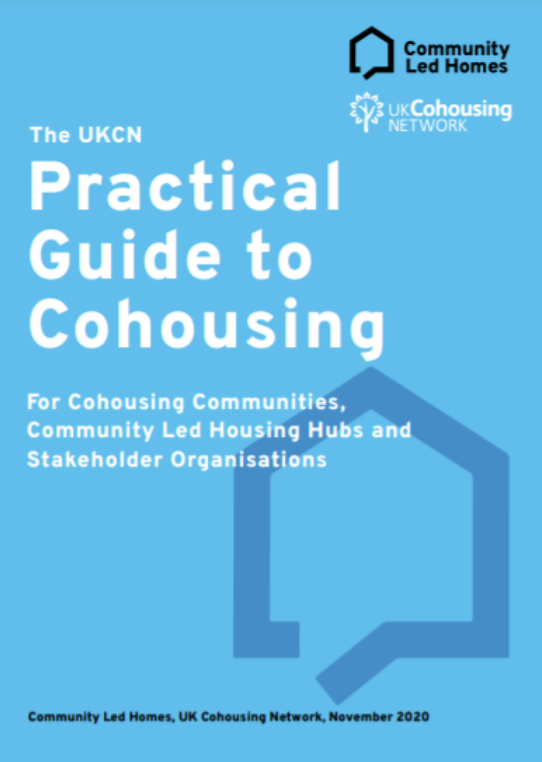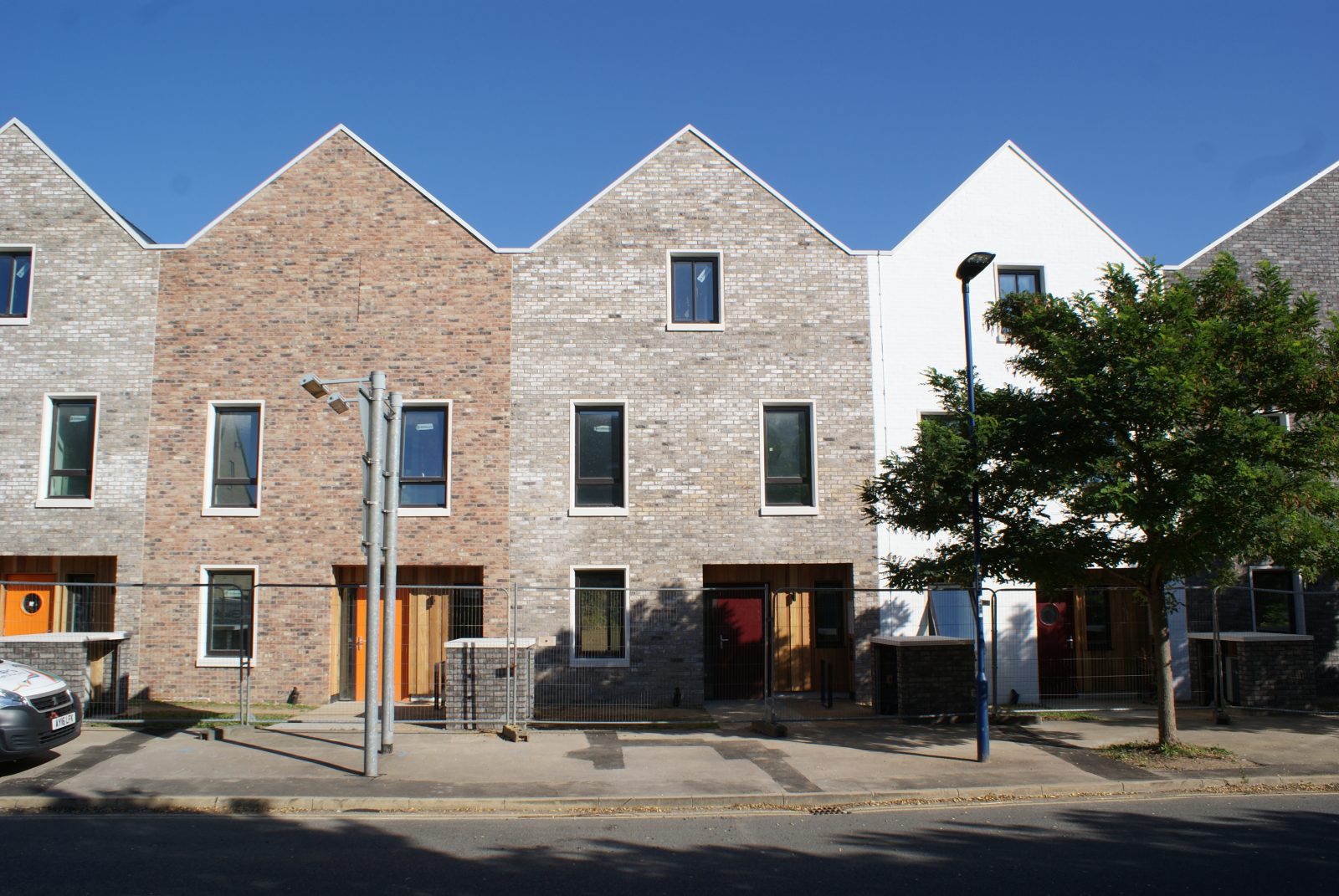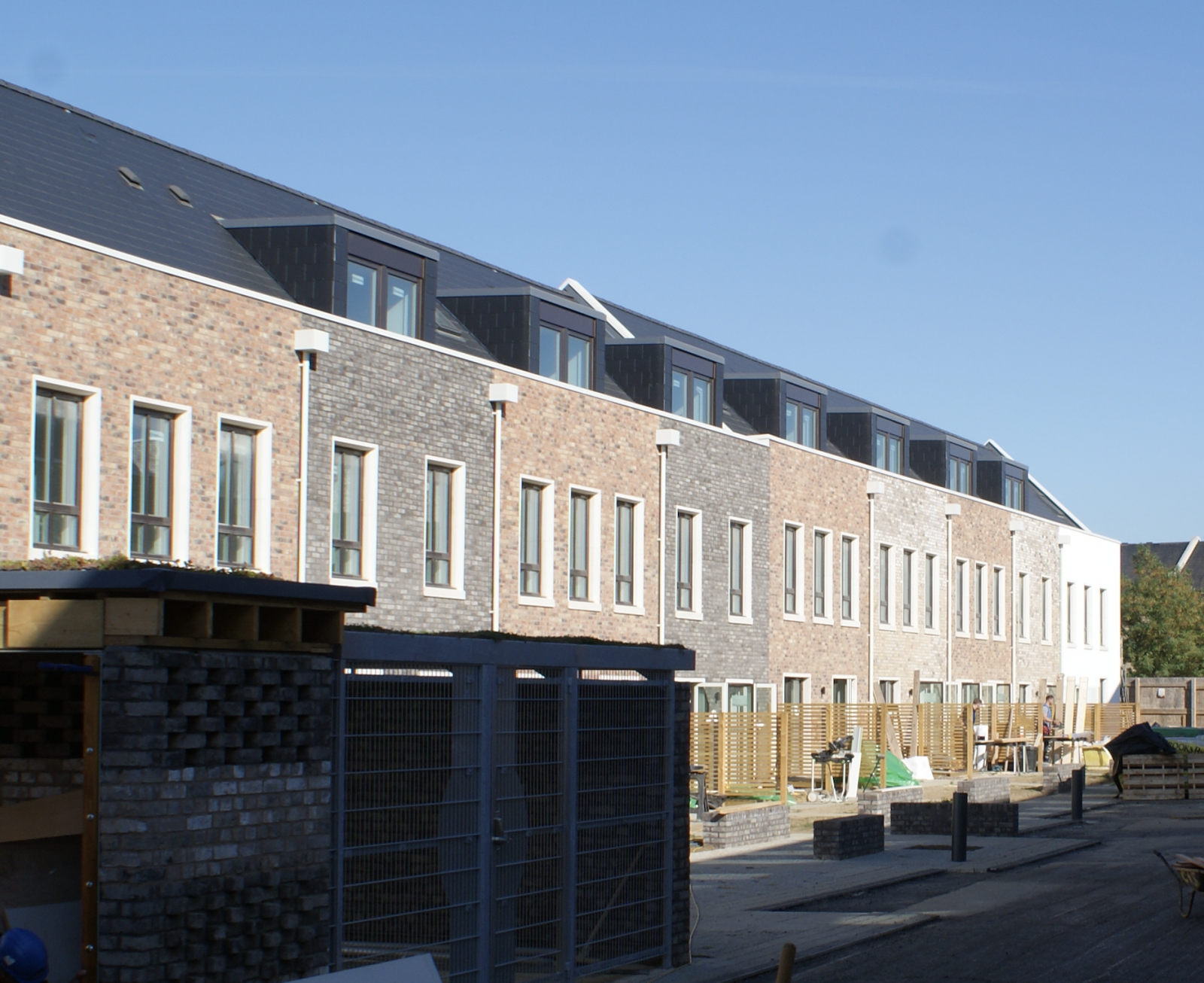The Community Land Trust (CLT) Network has published a report on CLT activity that points to a huge potential for this approach to community led homes to deliver many more homes.
Models vary, but many such communities will fall into the category of being a self build when the initial owners have some input into the initial design, but this varies trust by trust.
In its State of the Community Land Trust Sector report the CLT Network finds that there is a potential for communities to deliver at least 278,000 homes across England and Wales. However, this can only be achieved through the use of replicable models supported by industry partnerships.
The report goes on to frame five distinct models that can be repeated, including applications suitable for urban and rural communities, which makes it a useful resource for anyone considering setting up a community land trust.
Currently there are 350 CLTs, with 209 more being created, and many of these are working to create homes in either areas that are unaffordable or deprived. CLTs have also delivered 1,711 affordable homes, with 5,413 in the pipeline.
To find out more about projects in progress near you, visit Community Land Trust Network, or for insight into the different community-led housing models visit Community Led Homes website.
What is a Community Land Trust?
CLTs are set up by a community to steward land, with a very local emphasis. This might be a garden or civic buildings, but is often land for affordable homes, which the group then bring forwards or commissions, typically working with partners, such as a landowner, council or registered social housing provider.
The land in question is held in trust, keeping homes affordable forever, meaning that they are not for everyone, but are very welcome by the communities around them.
Don’t forget, if you are interested in building or commissioning a home of your own you should sign your local authorities’ register, and you can do this both as an individual and as a group – so that the council is aware of group’s wishing to build locally.
The island community of Raasay is welcoming the start of a new development that offers much needed local housing, with a start on a site of five community-led and five affordable self build plots. The combination of house types and tenures offers a solution to housing for rural communities that could be replicated elsewhere.
With support from the Communities Housing Trust, the Raasay Development Trust is leading the project and will ultimately manage the three community-owned homes for affordable rent, with the other two community homes available for social rent with Lochalsh & Skye Housing Association.
The remaining five affordable self-build plots will be discounted with the Rural Housing Burden, which is unique to Scotland, which guarantees affordability in perpetuity as it controls future sales linked to the local community. The plots are also smaller than open-market plots, which also helps with affordability.
The community-owned site was purchased by the Trust with funding from the Scottish Land Fund in 2020, with further key funding from the Scottish Government’s Rural & Islands Housing Fund, and Ecology Building Society, who may also be able to provide mortgages for the self-build homes.
Like many rural communities, Raasay has seen an increase in demand for affordable housing, and this solution provide valuable new homes to meet this need, for people with a link or need to live on the island.
Anyone interested in the plots should register with the Communities Housing Trust, with the Raasay Development Trust managing the allocations process, and the Trust also recommends those in housing need to register with the Highland Housing Register.
Chair of Raasay Development Trust, Iain Hector Ross, said: “Raasay has a clear and present need for new affordable housing stock to meet the growing demand from young islanders choosing to stay and others wanting to move to the island for increasing work opportunities.
“We are fortunate that the island is enjoying an era of growing economic confidence and opportunity, where young people now see a long-term future for themselves here. Quality housing is vital to support that future and we hope that the delivery of these new homes is just the first step towards providing every young islander with an affordable option.”
Jon Lee, community housing lead at Ecology Building Society, said: “We’re excited once again to work alongside the other funders to support this development on Raasay. Providing funding for affordable, energy efficient, community-led housing and to encourage sustainable self-build particularly chimes with our mission to build a greener society.”
Image: Raasay Development Trust director Ali MacInnes marks the start on site
A series of roadshows in Scotland is sharing cohousing inspirtaion for anyone interested in housing designed and managed by residents, with events in Inverkeithing, Glasgow, Edinburgh and Lenzie.
Cohousing Scotland, the national Cohousing umbrella organisation, is staging the roadshows as part of the Places Called Home initiative, funded by IKEA and The National Lottery Community Fund.
Cohousing projects are created and run by their members, and typically commission their homes to suit the way the group wants to live, with a series of private residences and communal areas, such as gardens or common rooms. Residents commit to look out for each other, enjoy and maintain the shared common spaces while enjoying their own, self-contained homes, creating an alternative approach to housing. Cohousing communities often have a strong emphasis on environmental sustainability and ecological design, with the projects frequently winning awards.
Cohousing Scotland convener, Andrew Prendergast said: “We want more people in Scotland to know about Cohousing and all it has to offer.
“Currently, housing provision centres on the commercial developer-led private sector, on the one hand, and state-led social provision on the other. We believe it is time to look to new and innovative ways to solve our country’s housing crisis.
“Cohousing Scotland sees a future where Cohousing is part of a thriving, community-led housing movement in Scotland – now is the time for change.”
About the roadshows
Each of the upcoming locations (Inverkeithing – June 7, Glasgow – June 9, Edinburgh – June 15 and Lenzie – June 22), follows broadly the same format: an afternoon drop-in session providing information about wider housing issues, followed by an evening panel discussion led by expert panellists.
During the afternoon, a team of young architects from the Imagine If collective will host an interactive game session, exploring what ‘home’ means and what our living spaces could look like in the future.
The roadshow is a free, open event.
Tuesday 7 June: Inverkeithing, Fife – Civic Centre, Queen Street, Inverkeithing KY11 1PA. Format: Drop-in: 2.30pm to 5pm, Panel discussion: 7pm to 8.30pm. Book here
Thursday 9 June: Glasgow – Quaker Meeting House, 38 Elmbank Crescent, Glasgow G2 4PS. Format still to be agreed, possibly no drop-in session (be advised), Panel discussion: 7.00pm to 8.30pm. Book here
Wednesday 15 June: Edinburgh – Augustine United Church, 41 George IV Bridge, Edinburgh EH1 1EL + ONLINE. Format: Drop-in: 4pm to 5.30pm, Panel discussion: 7.00pm to 8.30pm. Book here
Wednesday 22 June: Lenzie – Golf Club, 19 Crosshill Road, Lenzie, Glasgow G66 5DA. Format: Drop in: 3.30pm to 5.30pm, Panel discussion: 7.00pm to 8.30pm. Book here
For more information about a range of community led housing models, visit Community Led Housing
Image credit: Cohousing vision by Imagine If
Community groups working to build their own homes will welcome the news that government has launched a £4million Community Housing Fund grant programme.
Housing Minister Christopher Pincher launched the fund recently, which is an extension to the Community Housing Fund, and is targeted at groups who are already organised and can prove their deliverability and are at the later stages of the pre-development phases.
The fund is administered by the Community Led Homes Partnership an umbrella organisation made up of the Confederation of Co-operative Housing, Locality, National Community Land Trust Network and UK Cohousing Network.
Community housing bodies, as well as NaCSBA, continue to lobby government to renew the wider Community Housing Fund, with news expected in the Comprehensive Spending Review in Autumn. Continuing the fund was one of the recommendations set out in the recently published Bacon Review, so the news of this interim fund is a welcome example of government’s willingness to support the sector.
Tom Chance, Community Land Trust Network Chief Executive said: “Community led housing groups are rooted in their communities and truly understand local housing needs. There are so many fantastic projects planned across the country. This programme will help many of these projects come to fruition.
“This extension is very welcome news. But we know there are potentially 23,000 homes in the pipeline and without further Community Housing Fund most will not happen. So our campaign calling for the fund to be renewed for a further 4 years continues.”
The fund is already open to applications until 31 December 2021 (or the money is allocated), and the works funded by the grant must be completed by the close date of March 2022.
To apply complete an eligibility checker on the Community Led Homes website. Eligible groups will then be emailed an online grant application form.
Collaborative Housing is co-ordinating the online Thames Valley Community Led Housing Festival, 10-14 May, the perfect opportunity to find out more about community led housing. Aimed to planners, developers and local authorities, the festival is a great opportunity for anyone interested in learn about this diverse route into housing.
During the event you can learn about the political landscape around community led housing, as well as hear from group members working to create, or living in, projects around the Thames Valley.
The focus is very much about scaling up community led housing, looking at the opportunities and challenges around the delivery fo large-scale community projects.
Duncan Hayes of NaCSBA will be speaking at the event, discussing how the Right to Build works for groups and sharing some learnings.
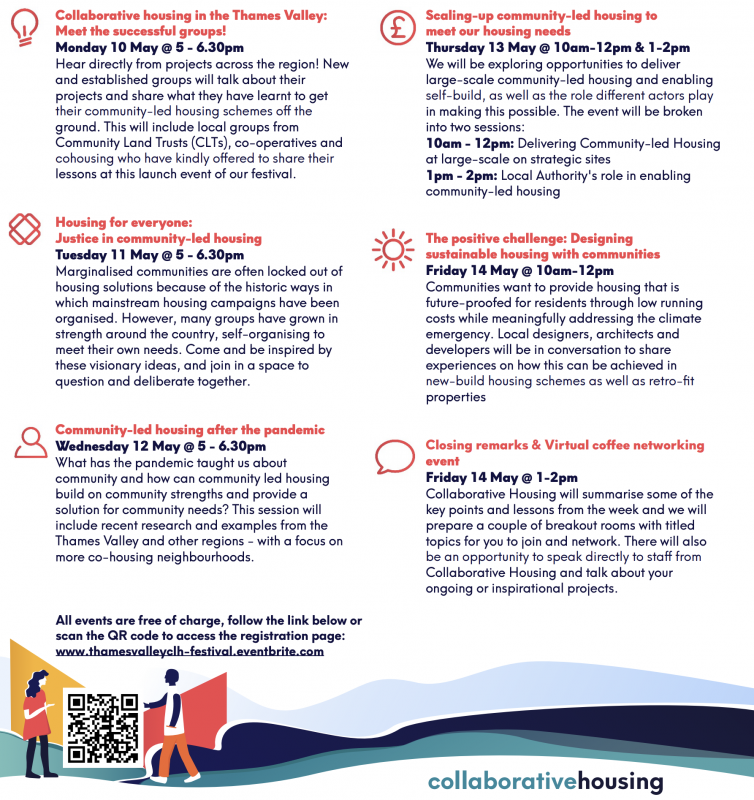
collaborative housing festival
Government recently announced the winners of its cross-departmental Homes of 2030 competition, with igloo Regeneration’s custom build +Home being the joint winner with Connector Housing. Led by RIBA and BRE, the competition was looking for innovative housing solutions that met the climate challenge.
The judges were looking for projects that would bring about change through innovation and delivery, and feed into government housing policy. The winning and runner up designs will be built for the Future Living Expo Sunderland 2023, giving visitors the chance to experience the low carbon, smart buildings first hand.
Winning projects
Announced by Housing Secretary Chris Pincher, the joint winning projects were +Home and Connector Housing. At HOMES UK, Christopher Pincher MP said: “Two entries really captured the judges’ imaginations – their designs show the way housing in this country can be reimagined and for that I would like to sincerely congratulate both winners of these worthy awards.”
+Home
This design (main image) is based around the idea of custom build homes that people design for themselves, creating a community-led approach. +Home is repeatable, enabling people to create affordable homes, thanks to simple, and low-carbon components, such as frames, that are also recyclable. The design was created by igloo Regeneration with Useful Projects, Expedition Engineers and Mawson Kerr.
Mark Hallett of igloo, a NaCSBA member, said, “Igloo have been advocating for Custom Build for a decade now as well as delivering a small number of pilot projects. We believe Custom Build should be a mainstream option and so used the opportunity of the Home of 2030 competition to advocate for this approach to Government.
“There are big system change challenges to overcome but we hope that building all six of the Home of 2030 winners as part of the Sunderland 2023 expo will help to publicise Custom Build to a wider audience.”
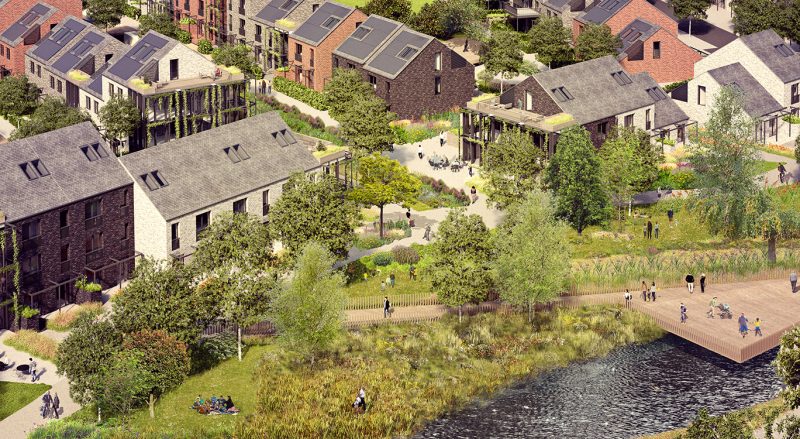
Connector Housing – Openstudio / LDA Design / Hoare Lea / Gardiner & Theobold
Connector Housing
Based around the design of units that work together, Connector Housing relies on ‘Connector’ units to create different building types at that allow flexibility in terms of density and design.
The Connector is a vertical model used to create stairwells, storage and work spaces or to provide access to communal gardens. Combined with ‘base’ and ‘loft’ units, the components can be used to create houses or apartments.Connector Housing was designed by Openstudio with Hoare Lea, LDA Design and Gardiner & Theobald.
Anyone considering a community led homes project will be interested to know that the clock is ticking for proposals to be submitted for a 0.10acre site in Waltham Forest, London, with submissions due 11.1.21.
The land is available to deliver affordable housing in the London Borough of Waltham Forest, and the council is keen to hear from community led housing groups in the area who are looking for a site.
The land in question is a former garage site in a residential area of terraced housing, which is currently partly being used for parking. There is a range of site investigations already undertaken, that bidders will want to see.
Find out more and download the lease, details and site particulars on the Greater London Authority site.
You can also contact the council’s community led housing team.
Mayor of London Sadiq Khan has created a new website for selling small publicly-owned sites as a pilot for providing plots for the capital’s small- and medium-enterprise builders.
Find out more about community living with Community Led Homes and Community Led Housing London.
Mayor of London Small Sites
For small developers and groups, the Greater London Authority hosts a Small Sites webpage, with links to small, publicly-owned parcels of land that are suitable for delivering housing. The sites are available for developers, housing associations and communities.
An initiative of Mayor Sadiq Khan, the site was originally piloted in 2018 to market 10 small sites for London’s small- and medium-enterprise (SME) house builders. Since then, the site has grown offering SMEs and groups a route to publicly-owned land, making it a valuable resource.
There are currently 40 sites available through the Small Sites, Small Builders programme, details of which are available on the website or via the newsletter. Sites to look out for are Tower Hamlets which is release a series of small sites to self builders as part of its Affordable Self Build Programme.
As well as sites owned by local authorities, some land is owned by Transport for London. The site also includes resources for small builders, including links to development finance.
[/ow]
The National Custom and Self Build Association (NaCSBA) has partnered with UK Cohousing Network, National Community Land Trust Network and the Federation of Master Builders to create a new group called Housing Diversification. It’s aim is to persuade Government to create more opportunities for more people to live in custom build, self build and community-led housing. These are houses are typically built by small- to medium-enterprise (SME) housebuilders.
Together, the groups believe that this type of housing could result in an extra 130,000 homes being built by 2025. These homes would be additional units, in that they would be extra to the homes built by the major housebuilders in this period, and therefore help government in its ambition to build 300,000 homes a year.
Housing Diversification knows that the homes built by SME builders for self build and community-led projects are typically more sustainable, beautiful, innovative and of higher quality than many open market homes. In addition, these homes also boost the local economy, providing local jobs and training opportunities.
The number of SME housebuilders has fallen significantly since the 1980s, and halved following the last recession. These SME companies are vital for the supply of local houses, and opportunities must be created to allow them to operate on a level playing field with volume housebuilders, which have very deep pockets.
Campaigning for building back better
Housing diversification has three asks of Government:
- The establishment of a high-level Housing Diversification Taskforce, with a range of items set out for consideration (see Appendix).
- Commitment to a five-year renewal of the Community Housing Fund as part of the Comprehensive Spending Review.
- The creation of a robust and statutory system of reporting on diversification as part of Government housing statistics, including on the NPPF requirement for 10% of homes to be delivered on small sites (one hectare or less).
Housing Diversification members:
- NaCSBA, which runs the Self Build Portal, knows that 14,000 custom and self build homes are built each year, although many of these are single self builds. With greater Government support this figure could reach 73,500 by 2025, with custom build offering the scope to grow the sector with more serviced plots.
- The Federation of Master Builders represents 7,500 SME firms across the UK, half of which build new homes. FMB members expect to build more than 12,000 new homes in 2021. Members of the public can source contractors using its Find a Builder database.
- Currently there are 10,780 community led homes in ‘live applications’ on Homes England system awaiting delivery, part of a wider pipeline of 23,000 homes. Many of these homes are reliant on the Government’s Community Housing Fund – which was closed in March. Getting it reinstated is one of the main ambitions of Housing Diversification.
- Community Land Trusts are a community-led housing model, where the land is held in trust, meaning that affordability is locked in for good. Cohousing refers to groups of people wishing to live together – as an ‘intentional’ community.
- You can find out more about these community-led housing models, and others, as well as how to start a group, on the Community Led Homes website.
Andrew Baddeley-Chappell, CEO, National Custom and Self Build Association and spokesperson for the group said: “Despite the importance of houses to our lives and the scale of their cost, there is currently too little choice when it comes to new homes in this country.
“We have come together as Housing Diversification to deliver more passion, quality, and care into the new homes and the new communities that we, as a nation, need to be creating. Just like any other market, increasing diversification will improve quality, innovation, and value. We will deliver homes more people want to live in and that more welcome being built.”
The Cambridge cohousing scheme, Marmalade Lane, has won the top award at the Royal Town Planning Insitute’s Awards 2020, adding to its already sizeable list of awards. Marmalade Lane was awarded the RTPI’s Silver Jubilee Cup having been entered by Greater Cambridge Shared Planning Service and development company TOWN, which is a NaCSBA member.
A first for Cambridge, the Marmalade Lane cohousing scheme was given the top prize as the judges felt that it demonstrated the value of community-led housing and a collaborative approach to planning.
The judges commented that the development puts the needs of the residents at its heart, and has created a distinctive and sustainable neighbourhood that was full of character.
Sadie Morgan, design industry leader and Chair of the judging panel, said: “Marmalade Lane shows the importance in new housing developments of greater local participation, increased opportunities for accessing nature and the prioritisation of people over cars – its design has helped create a place with a genuine sense of belonging and a rich local culture that harnesses the humour and warmth that are so vital in these challenging times.”
Marmalade Lane
Cambridge’s first cohousing project has its roots in the aftermath of the 2008 financial crisis, when the developers left the land in limbo. A cohousing group had formed in Cambridge, then called K1 Cohousing, and was looking for land, and the council supported the process of allocating the site for cohousing.
Working with community housing consultants Stephen Hill and Adam Broadway, they paved the way for the group to create Marmalade Lane and build the homes that supported them in the way they wanted to live.
Rather than pursue self build, Town was brought on as the developer, working with Mole Architects and Scandinavian eco-house builder Trivselhus to design and build the scheme on behalf of the residents.
The project is made up of 42 homes, customised to the residents preferences, but using a limited system of choice to ensure designs were replicable and cost-effective. This resulted in three house types, with 27 layout options, with mortgage finance provided by Ecology Building Society.
The result is a scheme of terraced houses and apartments, set around shared gardens and a pedestrianised play street, with a common house for socialising and cooking shared meals, should people wish to eat as a group.
What is cohousing
Cohousing is a form of community-led housing, where people come together to build and live in an ‘intentional’ community, with shared values. This may work with other community solutions, such as a Community Land Trust – which holds the land the project is built on in perpetuity, although this is not the case at Marmalade Lane.
A core principle is that most cohousing projects have shared elements. These often include a common room for socialising, but may include shared guest suites to keep spare rooms to a minimum, laundries, kitchens, and shared external design features, such as orchards, play streets, car parks, gardens and so on.
All the houses and flats have their own facilities, such as kitchens, so it is very much based around people wanting to live as part of a community, but they can still live independently. Costs and maintenance of the communal facilities are shared, so there’s typically a rosta for jobs.
But it represents a different way of living from the typical UK experience, where people and community underpin the homes, making it a transformative route to housing, that is growing in appeal.


